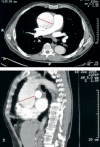Aneurysms of the ascending aorta
- PMID: 22532815
- PMCID: PMC3334714
- DOI: 10.3238/arztebl.2012.0227
Aneurysms of the ascending aorta
Abstract
Background: Aneurysms of the ascending aorta present a special challenge to primary care physicians, internists, and cardiac surgeons because they remain asymptomatic until they present with either dissection or rupture.
Method: This review article is based on a selective search of the literature.
Results: In the elderly, aneurysms of the ascending aorta are mainly caused by atherosclerosis. In younger patients, the most common cause is Marfan syndrome; less commonly, younger patients may have Loeys-Dietz syndrome, non-syndromic familial aortic aneurysms, or aortic valve malformations. Genetic variants predisposing to the development of sporadic aortic aneurysms have recently been identified. The risk of rupture and dissection depends on the aortic diameter: when the diameter exceeds 55 mm, surgery improves the outcome, as the risk of surgical complications is lower than the mortality due to rupture or dissection. A more accurate prognosis can be obtained by normalizing the aortic diameter to the body surface area. For patients with Marfan syndrome or a bicuspid aortic valve, the indications for surgery should be determined on an individual basis, depending on additional risk factors. Randomized treatment trials are lacking. The medical management of aneurysms of the ascending aorta consists of monitoring the size of the aneurysm, controlling blood pressure, and treating any cardiovascular risk factors. Patients with Marfan syndrome benefit from preventive treatment with beta-blockers. Advances in the pathophysiological understanding of aortic aneurysms have led to the testing of new types of treatment, e.g., with AT1 antagonists.
Conclusion: With the aid of a risk-based treatment strategy, surgery can be properly timed to prevent dissection, which is usually lethal when it occurs. More research is needed on the pathogenesis of this condition so that better preventive treatments can be developed.
Figures



Comment in
-
Additional criterion.Dtsch Arztebl Int. 2012 Jul;109(29-30):504; author reply 505. doi: 10.3238/arztebl.2012.0504a. Epub 2012 Jul 23. Dtsch Arztebl Int. 2012. PMID: 23056154 Free PMC article. No abstract available.
-
Addendum.Dtsch Arztebl Int. 2012 Jul;109(29-30):504; author reply 505. doi: 10.3238/arztebl.2012.0504b. Epub 2012 Jul 23. Dtsch Arztebl Int. 2012. PMID: 23056155 Free PMC article. No abstract available.
References
-
- Hiratzka LF, Bakris GL, Beckman JA, et al. 2010 ACCF/AHA/AATS/ACR/ASA/SCA/SCAI/SIR/STS/SVM guidelines for the diagnosis and management of patients with thoracic aortic disease: a report of the American College of Cardiology Foundation/American Heart Association Task Force on Practice Guidelines, American Association for Thoracic Surgery, American College of Radiology, American Stroke Association, Society of Cardiovascular Anesthesiologists, Society for Cardiovascular Angiography and Interventions, Society of Interventional Radiology, Society of Thoracic Surgeons, and Society for Vascular Medicine. Circulation. 2010;121:e266–e369. - PubMed
-
- Elefteriades JA, Farkas EA. Thoracic aortic aneurysm clinically pertinent controversies and uncertainties. J Am Coll Cardiol. 2010;55:841–857. - PubMed
-
- Cozijnsen L, Braam RL, Waalewijn RA, et al. What is new in dilatation of the ascending aorta? Review of current literature and practical advice for the cardiologist. Circulation. 2011;123:924–928. - PubMed
Publication types
MeSH terms
LinkOut - more resources
Full Text Sources
Medical
Research Materials

